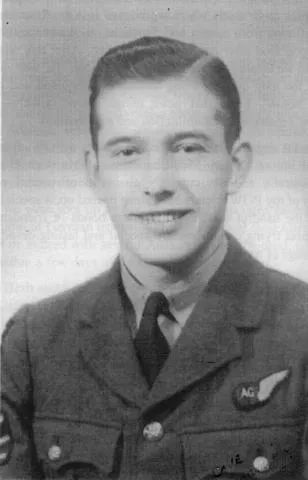W/Op Sgt. James Alexander Summers Philson landed safely in parachute in a field to the south of Havlykke farm near Belle. He folded up his parachute and hid it in a fence and started moving to the south. At dawn he reached Vejle fjord and hid in some scrub. Here he spent the whole day of 12/9.
At night he started moving to the north east navigating by the help of the North Star. When dawn arrived he came to the farm Røde Mølle and entered the barn and hid in the hayloft. Here he dug himself into the hay. Sometime during Saturday 13/9 a police car arrived and Philson saw a policeman with a dog entering the farmhouse. Shortly after the policeman left again without searching the place. Late in the evening Philson left the barn and started walking.
Since he had started walking late he had not moved very far when dawn approached. He hid in the small Spilkjær forrest near the railroad between Hedensted and Daugaard. It was raining all day Sunday 14/9 and in the evening he followed the railroad to Daugaard. Here he hid for the day in some scrub to the north of the station and watched the trains. In the evening he walked over to some goods wagons and entered a wagon with a brake hut. Here he fell asleep hoping to go on a train ride. The hope vanished when a railwayman opened the door to unlock the brakes.
Philson was then at 10:45 on 16/9 taken to the Daugaard Inn for interrogation by the Danish police. He was given food and treated very well. Later the same day, when Philson was picked up by four Germans, a young maid put some cigarettes into Philsons hand but the German officer snatched them from him and threw them on the floor, saying, that they (the Germans) could provide the prisoner's needs. Philson was taken to the German HQ in Vejle where he was met by a very fat German Major.
After a day or two Philson was put in a car and taken to Flensburg airfield where he spent two days, then on to Dulag Luft in Oberursel near Frankfurt for interrogation. After a few days he was sent to Stalag VIIIB, Lambsdorf near Breslau.
After six months he switched identity with the Australian Sapper Oswald Wall to be able to go on a working party away from the camp. He managed to escape from the working party camp Laband together with John Payne (Believed to be Sergeant J.F.Payne of 83 Sqn). They were on the run for 8 days before they were recaptured near Stenberwitz about 13 kilometers from Tropau and given two weeks in the cooler.
Early 1945 the prisoners of war were sent on a march away from the advancing Russian troops. Near Braunschweig Philson was liberated by the 9. American Division and a week later sent to England.Text and photograph of Sergeant Philson from AirWar over Denmark




